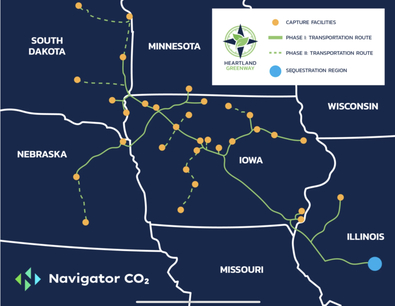* WBBM…
Carbon capture could be a way of the future for utilities, and Springfield appears to be on the leading edge. That’s because it has its own utilities.
Groundbreaking was Thursday for a federal-and-state funded plant. The US Department of Energy’s Lynn Brickett tried to convey how big a deal this is. […]
“We’re trying to remove carbon, essentially, from our emissions as we generate electricity from coal,” explained Doug Brown, the city’s chief utility engineer. “It’s an important project to basically start it at this larger scale, so they can actually scale it up to full-sized installations and when they prove that its economically done, then other companies will jump on board.”
The University of Illinois’ Prairie Research Institute is involved in the $67 million project. One lawmaker said this is almost as big for the U of I as the Illini basketball team’s win over Texas this week.
* WCIA…
The technology is designed to capture carbon dioxide in the atmosphere emitted from the plant’s large smoke stacks. After it makes its way through the equipment, a high purity form of carbon dioxide is formed and can be used for different purposes and stored in the ground. […]
This is a large pilot testing project meant to demonstrate how the technology works. […]
When the state passed the Climate and Equitable Jobs Act in 2021, coal plants like CWLP agreed to clean up emissions to keep their plants running until 2050. This is part of a long effort by the city to get a head start.
“When it comes to a project like this, it proves the benefit of the potential usage of Dallman 4 not only past 2040, which was the state guidelines, but beyond that,” Springfield Mayor Jim Langfelder said.
The Department of Energy awarded $47 million for the final phase of the project. The state gave an additional $20 million towards it.
* Carbon storage isn’t without controversy. In Benton County, Indiana, residents remain skeptical of environmental impacts. WFLI…
Benton County residents and elected officials want more information about BP’s possible plans to pipe carbon captured from its Whiting oil refinery to massive, underground sandstone deposits in Benton County. […]
House Bill 1209 outlines property-owner rights and sets parameters for companies planning to sequester carbon in certain underground parts of Indiana. Jeff Cummins, director of state government relations for Indiana Farm Bureau, advised legislators on the bill. […]
BP must reach agreements with 70% of landowners above the sandstone deposits, per the new state law, before proceeding, Cummins says. Before the bill passed, such agreements weren’t required, giving property owners less sway in the decision-making process, he adds. […]
The deposits are located 2,500-3,500 feet underground. Schmitt had this to say about the effect a leak might have on drinking water in the area:
“You can never say there’s no risks to anything, right? … If some got out, it would change the chemistry of the drinking water a little bit, right?” Schmitt says. “So that is a concern.”
* Illinois farmers and environmentalists remain wary as well. Illinois Newsroom…
Karen Brockelsby, a Taylorville farmer, questions the lease program being offered for use of private property. The company wants a 30 year lease with landowners. Brockelsby mentioned concerns about whether that lease will cover any environmental damage.
“If there are problems, who owns the problem? And who has to pay for the problem?” Brockelsby asked. “There are (also) concerns about whether or not insurance companies would cover any kind of damages that would result from CO2 rising back to the surface and damaging something.”
Burns-Thompson said they (Navigator CO2) maintains full liability with the 30 year lease program. […]
Ann Baskerville an organizer with the Illinois chapter of the environmental organization the Sierra Club and a member of the coalition to stop CO2 pipelines does not believe the pipeline will help the environment.
“This proposed pipeline is a false solution to the climate crisis we’re facing today, and puts unnecessary pressure on local landowners and farmers to turn over their land and livelihood to a fossil fuel company. CO2 pipelines extend the life of fossil fuels and undermine the significant climate progress Illinois has made. Illinois should focus on the acceleration of real climate solutions like the implementation of natural climate solutions and renewable energy projects,” Baskerville said.
* Here’s a map of the proposed pipeline…

The Illinois Commerce Commission began hearings about the pipeline in September. A schedule of the hearing dates with the Illinois Commerce Commission can be found here.
* Meanwhile, here’s the Sun-Times…
A key part of the Climate and Equitable Jobs Act would be job-training programs established through new state workforce development initiatives, officials promised to win broad support for the measure.
But 15 months after Pritzker signed what was touted as the most equitable climate change-fighting law in the country, the job-training programs those initiatives were supposed to establish in the growing green economy, helping workers and businesses like Benjamin’s Millennium II Enterprises, still don’t exist.
And not a single new ”equity” job has been created.
That’s despite the promised job-creation efforts Pritzker’s state Department of Commerce and Economic Opportunity is supposed to set up — for which it was given the authority to spend as much as $180 million a year. The money, from a fund paid for by customers of Illinois utilities, also can be spent on economic development aid — for instance for communities that might have lost jobs from, say, the closing of a coal-burning power plant or a mine as a result of the state’s big push to move to renewable energy sources like wind and solar power.
* More…
* The Conversation | Cumbria coal mine: empty promises of carbon capture tech have excused digging up more fossil fuel for decades: The idea that a technology called carbon capture and storage (CCS) could catch molecules of CO₂ as they emerge from the chimneys of power stations and factories has been around for more than two decades. Michael Gove, the secretary of state responsible for “levelling up” the UK’s regions, recently justified his approval of the UK’s first new coal mine in 30 years with “increased use of CCS”. There’s only one problem: CCS won’t cancel out Woodhouse Colliery’s emissions, which are estimated at 400,000 tonnes a year, because it barely exists.
* Inside Climate | Carbon Removal Is Coming to Fossil Fuel Country. Can It Bring Jobs and Climate Action?: Scientists have debated whether a new technology is a critical climate solution or would carry unacceptable risks. A project in Wyoming’s coal region could begin to provide answers.
* Des Moines Register | Dueling views on carbon capture pipelines play out in downtown Des Moines: But the projects have been controversial in Iowa, with opponents concerned about pipeline safety, the impact on farmland the pipelines would cross and the likelihood developers will be granted eminent domain powers to force property owners to sell access to their land.
* NPR | The U.S. wants to slash carbon emissions from power plants. Natural gas is in the way: Under President Joe Biden, the United States aims to cut all carbon pollution by 2035 from the power plants that run American homes and businesses. It’s a first step toward the broader goal of zeroing out greenhouse gas emissions across the entire economy by midcentury to rein in climate change. But the ambitions of the Biden administration are set to collide with the country’s power industry, which looks like it will continue burning fossil fuels for the foreseeable future.
* S&P Global | Iowa carbon capture developer sues home county over new pipeline restrictions: Summit, based in Ames, Iowa, plans to build an interstate pipeline network to transport CO2 emissions from ethanol plants to an underground storage site in North Dakota, where the gas will be permanently sequestered. But the project faces opposition from some landowners concerned about pipeline safety and environmentalists critical of carbon capture. On Nov. 14, Summit and fellow plaintiff William Couser filed a lawsuit against the Story County, Iowa, Board of Supervisors, alleging the county’s recent ordinance on the siting of hazardous materials pipelines is preempted by state and federal law. The complaint was filed in the U.S. District Court for the Southern District of Iowa.














- Give Us Barabbas - Friday, Dec 9, 22 @ 11:05 am:
I’m skeptical of the technology, but rather more concerned about the fly ash waste piles across the street from the plant. No coal plants in Illinois are treating these as the true danger to local water and air that they are.
- Pot calling kettle - Friday, Dec 9, 22 @ 11:11 am:
Carbon capture and sequestration under ground is a bridge, not a long-term solution, and it should be treated as such.
Our current experience is mostly when CO2 is used for enhanced recovery in oil fields; while it has been mostly safe, there have been some incidents associated with the pipelines used to transport the CO2 to the injection sites. https://www.huffpost.com/entry/gassing-satartia-mississippi-co2-pipeline_n_60ddea9fe4b0ddef8b0ddc8f
With respect to deep sequestration, we are still learning a lot about where the CO2 goes and what happens to it and the rocks into which it is injected. These early projects are important and need to include observation, data collection, and analysis.
- Nobody Sent - Friday, Dec 9, 22 @ 11:18 am:
https://www.huffpost.com/entry/gassing-satartia-mississippi-co2-pipeline_n_60ddea9fe4b0ddef8b0ddc8f
- TheInvisibleMan - Friday, Dec 9, 22 @ 11:29 am:
–Karen Brockelsby, a Taylorville farmer, questions *didn’t read* the lease program being offered–
This is one of my pet peeves with much of local journalism. They will unquestionably print the ramblings of the uninformed, move on, and then people who read it think it’s accurate.
Thankfully, this story also includes the counter details to contradict the concerns of this particular karen.
More reporters should learn this lesson. Check if the things the people you are interviewing are accurate before you print them. You can still print the uninformed ramblings, but also make sure to include if they are factual claims or not.
- sulla - Friday, Dec 9, 22 @ 11:31 am:
It’s been real interesting to see farmers who sell their corn to the regional ethanol plants showing up to County Board meetings to oppose the Navigator Co2 pipeline. You know, that pipeline that sequesters Co2 emissions from ethanol plants.
- Chicagonk - Friday, Dec 9, 22 @ 11:39 am:
@sulla - That is a great point. Also the Sierra Club fighting carbon capture plants and pipelines just shows how unserious they can be at times.
- cermak_rd - Friday, Dec 9, 22 @ 11:45 am:
Pot calling kettle,
Yes, this looks more like a really cool science project than a solution, then again, I’m not sure that the solution isn’t going to look like a collage of different partial solutions.
- Anon221 - Friday, Dec 9, 22 @ 11:51 am:
TheInvisibleMan- Where in that article did it state that Ms. Brockelsby had not read a lease?
- DuPage - Friday, Dec 9, 22 @ 12:12 pm:
Better use of the money would be to invest in other cleaner energy projects. Natural gas is much, much cleaner then coal. Proposed wind power line projects could be expanded by making the towers taller and adding more lines. Then large amounts of wind energy could be brought into Illinois. Utility sized battery storage farms could provide power backup in the case of calm winds. The battery farm can pay for itself by charging up during low cost off-peak and then used to supply power during peak hours. There are many better uses for that money that would actually pay off in the long run.
- Honey Roasted - Friday, Dec 9, 22 @ 12:21 pm:
Every Dollar Spent on This Climate Technology Is a Waste.
From NYTimes:
https://www.nytimes.com/2022/08/16/opinion/climate-inflation-reduction-act.html?referringSource=articleShare
- Anon221 - Friday, Dec 9, 22 @ 12:22 pm:
Currently CO2 pipeline companies are doing as much lease signing, surveying (”thumper trucks”), and suing (in some cases- Google Iowa counties and zoning for C02 pipelines) that they can before new regulations are enacted. It may take until 2024 before the Pipeline and Hazardous Materials Safety Administration is through with their review… prompted in part by what happened in Mississippi.
One targeted area in Illinois for final sequestration is the federally recognized sole source Mahomet Aquifer. Based on what has happened with the Manlove Gas Field in that area, I believe caution should be practiced before endorsing this form of carbon capture and sequestration (CCS).
The shaded area on the map in this article encompasses a good portion of the Mahomet Aquifer.
https://tinyurl.com/bdev9432
There might be another way that CCS could possibly be done that could generate local energy without hundreds of miles of pipelines and all the potential issues those sorts of plans entail. And it also might generate more long term local jobs that the pipelines.
https://electrek.co/2022/11/14/the-worlds-first-co2-battery-for-long-duration-energy-storage-is-headed-to-the-us/
More info on what needs to be looked at before jumping blindly on CCS.
https://pstrust.org/wp-content/uploads/2022/10/CO2-Regulatory-and-Knowledge-Gaps-1.pdf
- H-W - Friday, Dec 9, 22 @ 12:29 pm:
I must confess I do not understand this whole concept of “capturing” carbon, and putting in deep in the ground.
I have to believe that if you put gasses into a deep well, and then seal it, the gasses must eventually be released, since gas is lighter than earth. Whether that takes millennia or decades or years, and whether or not this happens due to unanticipated fractures and faults, or some other natural event, I just have to believe at most, this is a temporary fix to a polluting problem.
But I am not a natural scientist or engineer. Thus, I have to put my faith in their expertise.
- Pot calling kettle - Friday, Dec 9, 22 @ 12:31 pm:
==the Sierra Club fighting carbon capture plants and pipelines just shows how unserious they can be at times==
It is not “unserious” of the Sierra Club. They understand that some folks in the fossil fuel industry promote this as a long-term solution that will allow us to continue to use fossil fuels without consequences. CC&S is not that; it has consequences, many of which are not currently known. Continued extraction and burning of fossil fuels has many negative consequences (well beyond carbon emissions) which are expanding as we move more heavily into tight oil and gas extraction and mountain-top removal mining of coal (among other things). They see CC&S as a fig leaf covering that could slow our move to more sustainable solutions.
- Henry Francis - Friday, Dec 9, 22 @ 12:58 pm:
== The University of Illinois’ Prairie Research Institute is involved in the $67 million project. One lawmaker said this is almost as big for the U of I as the Illini basketball team’s win over Texas this week.==
Look, I don’t know if this project will work or not, but comparing it to 1 basketball game (regular season, non-conference no less) is just a ridiculously dumb. And demonstrates how unserious this legislator’s priorities are.
- Boomer remover - Friday, Dec 9, 22 @ 1:04 pm:
This is,awesome for jb. Its another accomplishment in another hot button area that wall propel him to then front of the field in 2024 historic presidential run.good job jb
- MisterJayEm - Friday, Dec 9, 22 @ 1:17 pm:
“Carbon capture and sequestration under ground is a bridge, not a long-term solution, and it should be treated as such.”
Absolutely. (See also: electric cars and giant turbine farms.)
They’re all steps in the right direction, not destinations in themselves.
– MrJM
- Unedited - Friday, Dec 9, 22 @ 1:18 pm:
You would think the Springfield “newspaper” might have covered this, but you would think wrong. Guess they were too busy with Chris Kattan having pneumonia.
- Rich Miller - Friday, Dec 9, 22 @ 1:30 pm:
===Chris Kattan having pneumonia===
Did you see that Beef o’ Brady’s is closing? /s
- TheInvisibleMan - Friday, Dec 9, 22 @ 1:46 pm:
–Where in that article did it state that Ms. Brockelsby had not read a lease?–
Where it says her ‘questions’ are specifically answered by the language in the lease.
- froganon - Friday, Dec 9, 22 @ 1:52 pm:
==the Sierra Club fighting carbon capture plants and pipelines just shows how unserious they can be at times==
The Sierra Club is spot on about this. Carbon capture is an experimental technology that provides fossil fuel corporations with another way to bilk taxpayers. Those companies aren’t investing their dollars in this scheme. They demand taxpayers cover the costs with the usual perks. If it works, they sell it to us at a profit, if it fails we pay for costs and the damages. Utilities and fossil fuel companies need to radically change their business plans and expectations to transition into clean energy. They are so-o-o not interested in that kind of transition. They want yet another gravy train of tax subsidies as they keep the pipelines going. If those funds were invested in clean energy and in requiring sustainable farming practices we could pull 14.8 gigatons of carbon out of the atmosphere by 2050 and prevent additional carbon release form fossil fuel burning. See Drawdown, Comprehensive Plan to reverse Global Warming by Paul Hawken #23 - Farmland Restoration.
- Anon221 - Friday, Dec 9, 22 @ 2:18 pm:
TheInvisibleMan- The word “lease” only appears 4 times in that article. Are you saying that the reply from the Navigator spokesperson on liability automatically covers any and all environmental concerns Ms. Brockelsby may have in regards to lease language? What happens after 30 years?
- Dan - Friday, Dec 9, 22 @ 2:22 pm:
Shoulda had the FutureGen project years ago but that’s CO2 under the bridge now…
- JM - Friday, Dec 9, 22 @ 3:12 pm:
Just putting this here for the folks calling out the Club as unserious for not trusting fossil fuels interests https://www.washingtonpost.com/climate-environment/2022/12/09/oil-companies-house-documents-climate/
- Dotnonymous - Friday, Dec 9, 22 @ 3:44 pm:
“But I am not a natural scientist or engineer. Thus, I have to put my faith in their expertise.” - H.W.
The problem with that faith is that many of these scientists and engineers put their faith in whatever profitable money making schemes their corporate bosses create…potentially dangerous short term “solutions” like carbon capturing included.
- Dotnonymous - Friday, Dec 9, 22 @ 3:48 pm:
https://www.history.com/this-day-in-history/gas-cloud-kills-cameroon-villagers
- Pot calling kettle - Friday, Dec 9, 22 @ 4:25 pm:
==One targeted area in Illinois for final sequestration is the federally recognized sole source Mahomet Aquifer.==
That’s not correct; CO2 would not be injected into a potable aquifer nor would it be injected into a shallow geologic unit with minimal confinement. Injection is into very deep rock layers under multiple confining layers (like clay and shale) that contain water not suitable for drinking.
==the gasses must eventually be released, since gas is lighter than earth==
Not necessarily. The CO2 can dissolve in the water and it can react with the geologic materials to form solid minerals. The fate of the injected CO2 is a primary area of research.